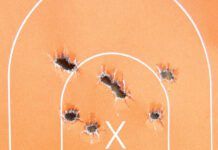Trends in firearms sales reflect the needs and interests of the buying public. Whereas the AR-15 or “black rifle” market has slowed down considerably, the popularity of rifles that are capable of accuracy beyond the 300-, 600-, or even 1000-yard range is still going strong. Referred to as precision rifles, the traditional configuration of a barreled action bedded into a wood or fiberglass stock are being challenged by aluminum and synthetic chassis rifles. What’s more, the 6.5 Creedmoor cartridge is rapidly becoming a favorite round. In this test, we decided to review three different types of rifles chambered to propel 0.264-inch diameter bullets that represent options to satisfy the long-distance enthusiast.
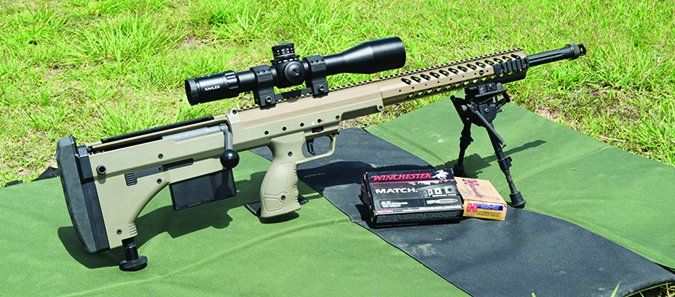
In this test, the traditional bolt-action rifle was represented by a new offering from Ruger that has, to the best of our knowledge, received virtually no press. Our $1139 6.5 Creedmoor Hawkeye MkIV Varmint Target boasted a 28-inch-long barrel, the longest tube we’ve heard of in quite some time. Howa’s $1450 HCR (Howa Chassis Rifle) was next up, featuring a fully adjustable buttstock from LUTH AR. Finally, we tried a unique design by Desert Tech. The $4995 Stealth Recon Scout (SRS-A1) lives up to its name by offering a 26-inch-long barrel packed into a compact profile.
Range Data
| Winchester 6.5 Creedmoor 140-gr. Match BTHP | Howa HCR | Ruger Hawkeye MkIV VT | Desert Tech SRS A-1 |
| Average velocity | 2673 fps | 2717 fps | 2686 fps |
| Muzzle energy | 2221 ft.-lbs. | 2294 ft.-lbs. | 2242 ft.-lbs. |
| Average group | 0.65 in. | 0.70 in. | 0.45 in. |
| Hornady 6.5 Creedmoor 143-gr. Precision Hunter ELD-X | |||
| Average velocity | 2567 fps | 2619 fps | 2607 fps |
| Muzzle energy | 2092 ft.-lbs. | 2178 ft.-lbs. | 2158 ft.-lbs. |
| Average group | 0.80 in. | 0.40 in. | 0.65 in. |
| Hornady 6.5 Creedmoor 147-gr. ELD Match | |||
| Average velocity | 2570 fps | 2643 fps | 2656 fps |
| Muzzle energy | 2156 ft.-lbs. | 2280 ft.-lbs. | 2302 ft.-lbs. |
| Average group | 0.80 in. | 0.60 in. | 0.55 in. |
| To collect accuracy data, we fired five-shot groups from the prone position. Distance: 100 yards. We recorded velocities using a LabRadar Doppler chronograph. | |||
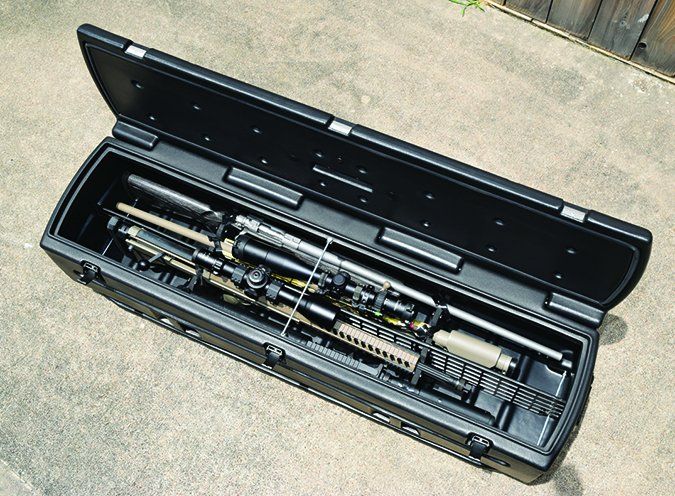
For optics, our rifles shared a Steiner 4-16x50mm Predator Extreme scope. We also took turns looking down range with a Kahles 3-12x50mm scope supplied by Desert Tech. We painstakingly took time to break in the barrel of each rifle and then fired from the 100-yard line at American Shooting Center in Houston to collect basic accuracy data. For shots of record, we chose Winchester 140-grain Match, Hornady 143-grain ELD-X Precision Hunter, and the new 147-grain ELD Match rounds. We also shot a variety of rounds left over from previous tests to perform break in and for general comparison. What were the strengths and limitations of these three different platforms? Let’s find out.
Desert Tech Stealth Recon Scout SRS-A1 6.5 Creedmoor, $4995
GUN TESTS GRADE: A
Test results proved the SRS-A1 is at the top of the pyramid. Compact overall length, user serviceability regarding takedown, and change of caliber makes its price point competitive because of its utility.

| ACTION TYPE | Bolt, telescopic, 60-degree throw |
| OVERALL LENGTH (min/max) | 37 in. |
| BARREL | 26 in., 1:8 in. twist, stainless steel |
| OVERALL HEIGHT (w/o scope) | 7.2 in. |
| WEIGHT UNLOADED | 11.4 lbs. |
| WEIGHT LOADED (6+1, 140-gr.) | 12.25 lbs. |
| SIGHT RADIUS | N/A |
| ACTION | FDE finish, flat-top Picatinny |
| BARREL | Matte black stainless steel, fluted w/ ported muzzle brake |
| MAGAZINE CAPACITY | 6 |
| MAGAZINE TYPE | Detachable box, single column |
| BUTTSTOCK | FDE polymer, adjustable rubber buttpad, adjustable cheeckpiece, rear monopod |
| BUTTSTOCK LENGTH OF PULL | 15.4 – 16.4 in. (adjustable) |
| HANDGUARD | Modular free float |
| TRIGGER | 2.95 lbs. pull, adjustable for travel, creep, location, weight |
| SAFETY | Sliding, ambidextrous |
| WARRANTY | 3 years; half-inch MOA guarantee |
| TELEPHONE | (801) 923-6425 |
| WEBSITE | DesertTech.com |
| MADE IN | USA |
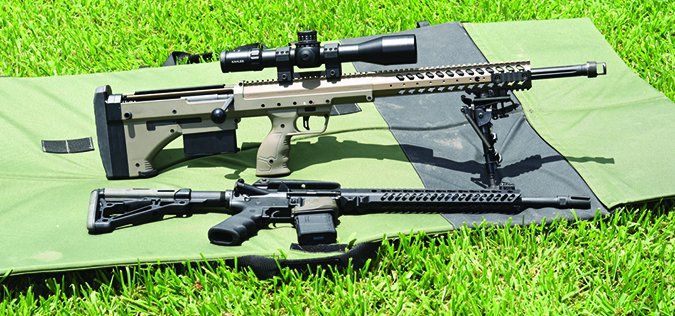
Whenever one test gun costs much more than the other firearms in a given test, we have to wonder how the price tag is going to be justified. When it comes to precision rifles touted for accuracy, buyers are going to want to see a big difference in the size of groups per dollar. Bear in mind that a jump in accuracy from, say, 1 minute of angle (1-inch groups at 100 yards) to 0.70-inch groups is a lot easier to achieve than an improvement from 0.6-inch-wide groups to the half-inch mark. Then again, there are many other factors to consider in terms of what the firearm brings to the shooter. A very good case in point is the Desert Tech Stealth Recon Scout, SRS-A1.
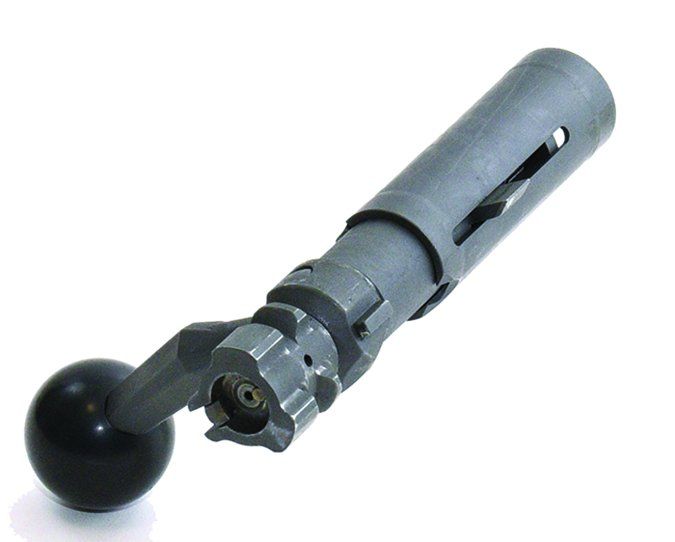
When we first became interested in the SRS-A1, we didn’t realize it was not necessarily a specific model but rather a system-based build. The first component to choose from was the chassis. Whereas the term chassis generally means a buttstock, grip, fore end, and action housing, in this case the Desert Tech’s polymer chassis included virtually every component except for the barrel, caliber-specific bolt, and magazines. So for a starting price of $3395, you are purchasing a platform consisting of receiver, stock, and trigger system that can be converted to multiple calibers. The first option was color. We chose FDE (flat dark earth) for the receiver and stock, but other choices were black/black and black/FDE. The next option was optics, if so desired, including a $12,320 AN/PVS-27 MUNS (Magnum Universal Night Sight), or a Kahles K624l ($3290) built on a 34mm tube.
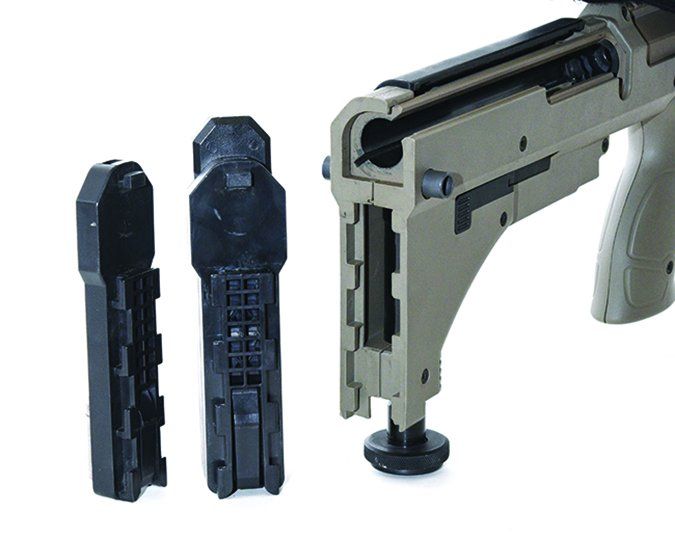
Then we chose a 26-inch-long barrel chambered for 6.5 Creedmoor at a cost of $1,600, including dedicated bolt and magazine. The threaded muzzle was fit with a single-port DT muzzle brake. Other choices for the SRS-A1 platform were 26-inch-long barrels chambered for 260 Remington, 300 Win. Mag., 308 Winchester, 338 Lapua Magnum, 6.5×47 Lapua, and 7mm Winchester Short Magnum. A 22-inch-long 308 Win. conversion kit was also available, and each model, including the more compact SRS Covert rifle, can be configured for the right-handed or left-handed shooter.
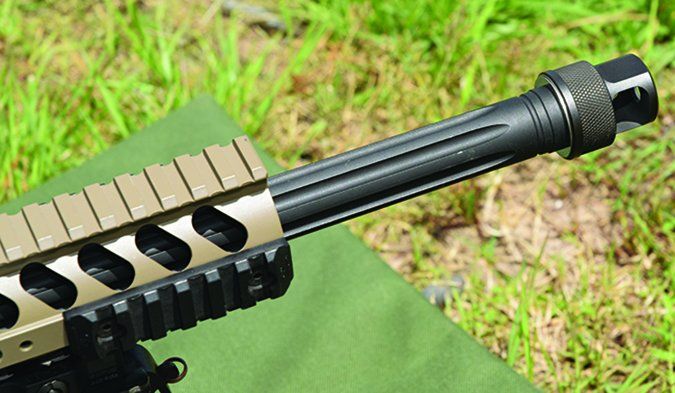
Our rifle arrived completely assembled, but a demonstration on YouTube showed us how easy it was to assemble or rebarrel the Desert Tech rifle. Insert the barrel downward through the forend with the notch in the chamber end facing 6 o’clock to the bottom of the rifle and make sure it seats into the receiver. If the barrel doesn’t rotate, then it is properly in place. Using a 5mm hex bit mounted on an 80-inch-pound torque wrench, tighten the barrel-lug screw located on the left-hand side immediately above the trigger. Then tighten the four barrel-retention screws found on the right-hand side of the rifle located above the trigger guard, and you are done.
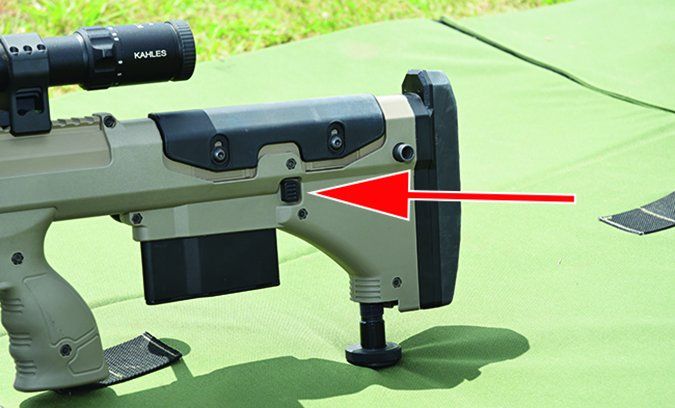
At the range, our first concern was how would we remove the bolt and clean the barrel to perform a barrel break-in routine, even though a Desert Tech representative assured us break-in was unnecessary. The manual said just run a bore snake through the chamber when accuracy erodes, but we also wanted to check the chamber and make sure the bore was clear before firing. We soon found out the buttpad and bolt stop were a cinch to remove. The buttpad and its three supplied spacers were each fit with their own individual release tabs. In the case of long-action chamberings, the face of the innermost spacer acted as bolt stop. Our short-action 6.5 Creedmoor model was fit with a plug inside the bolt channel to act as a bolt stop. The bolt was operated via a long handle with large balled end. The stock also had an adjustment to raise the comb, the surface of which was very comfortable. There was a monopod seamlessly integrated into the lower section of the stock that was adjustable by rotation. The base of the bipod was circular, measuring about 1.7 inches across with knurled edges. The threaded stem of the bipod was 0.75 inches wide and quite sturdy. The wide base did a good job of keeping the gun level.
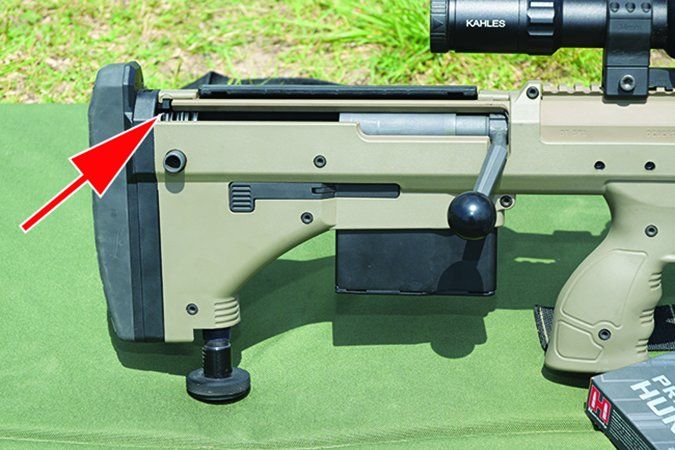
Another surprise for our team was how quickly we adapted to operating the bolt, positioned as it was behind our right hand and directly above the magazine. We really didn’t think anything of it after a few shots. Magazine-release buttons were located on both sides of the stock, but behind the strong hand, so that was a little awkward. The ambidextrous two-position safety was situated directly above the trigger so the index finger could easily slide it forward for Fire and rearward for Safe. The grip filled our hands pleasingly, and in our view lent much to controlling the rifle and indexing the trigger. While the SRS Covert model was designed for shorter barrels and offers a limited amount of forend and rail, our SRS-A1 had room for a 21-inch-long Picatinny rail at 12 o’clock, with two additional sections of 3-inch rail supplied and ready to bolt on where desired.
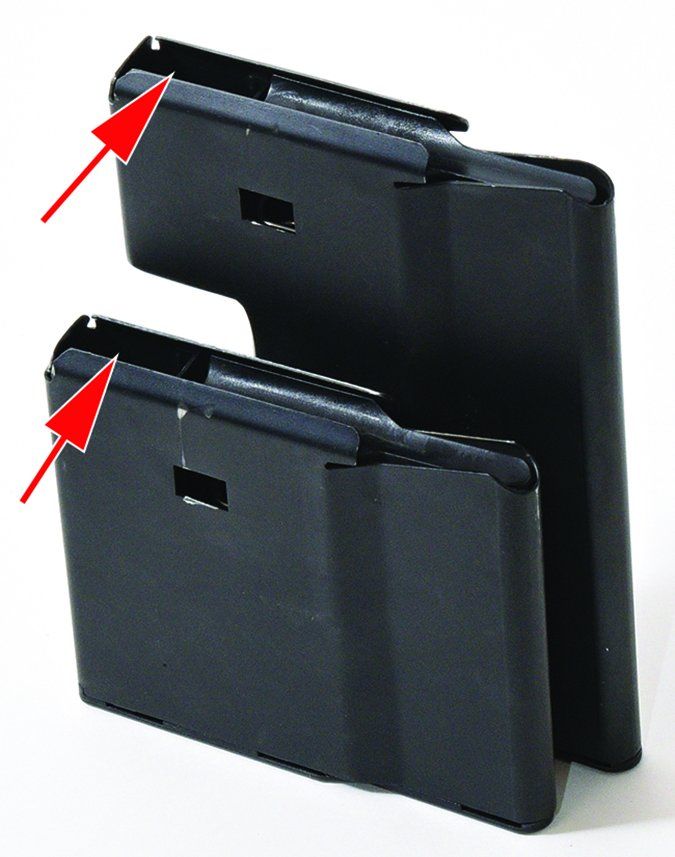
A six-round magazine was standard with an option for 10-rounders, which were tall thanks to the single-column design. Loading the mags required depressing the follower and sliding rounds in from the front. The bolt action was like so many things about the Desert Tech. Not fancy, it just plain worked without a hint of difficulty. The SRS-A1 preferred feeding directly from the magazine and did not like being single-round or top loaded unless you pushed the round forward into the chamber. The trigger was flawless, presenting a consistent 2.8 to 3.1 pounds of resistance.
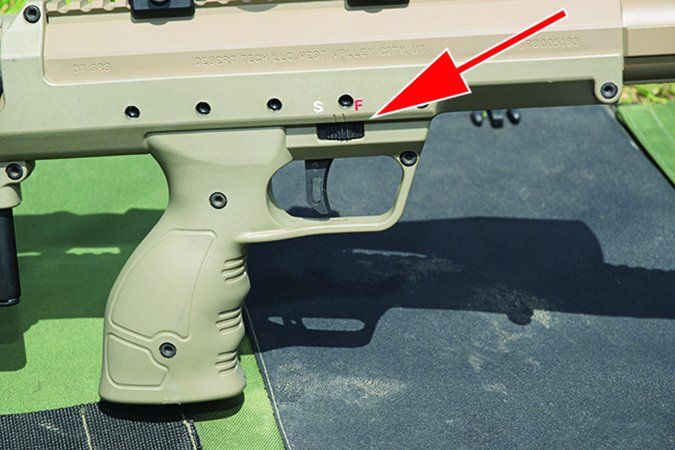
Desert Tech suggested we try the SRS-A1 in combination with add-ons and supplied a Harris Bipod and bipod (rail-to -stud) adaptor, and the Kahles 3-12x50mm scope mounted using Desert Tech’s special $365 mount system that offered six mounting screws per ring and an integral bubble-level. But it didn’t really matter if we shot the SRS-A1 using the $3200 Kahles or the $1000 Steiner. We printed consistent sub-MOA groups with little effort. The 143-grain Hornady ELD-X rounds produced an average of about 0.65 inches across for five-shot groups. The 147-grain ELD Match rounds were better, producing an average of 0.55 inches. Our best groups ranging in size center to center from about 0.35 inches to 0.55 inches were fired after loading the Desert Tech SRS-A1 with Winchester’s 140-grain boat-tail hollow-point Match.
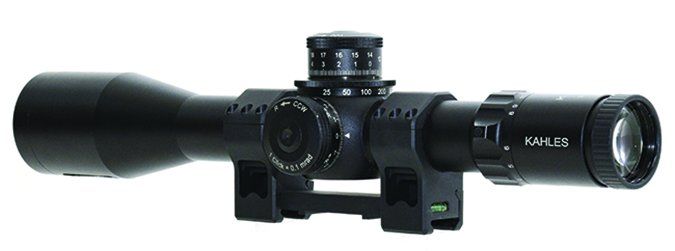
Our Team Said: The Desert Tech proved to be shooter friendly despite our initial apprehension. The integral monopod was voted the best such component we’ve used. The trigger was a dream to shoot, and operating the safety proved instinctive. If the initial cost was high, it was not out of line with other high-end rifles, and you’ll never need to pay a gunsmith to change caliber, replace a worn barrel, or change to a different barrel length to suit a specific task. In terms of accuracy, we’ve come to expect small groups from this cartridge, but its performance shooting every brand of commercial 140-grain Sierra BTHP bullets we tried will put many handloads to shame. We especially liked the Desert Tech scope mount for its ease of mounting. Portability was unmatched for a fixed-stock rifle prepared for long-distance shooting.
Legacy Sports Howa HCR HCRL92502MCCFDES 6.5 Creedmoor, $1450
GUN TESTS GRADE: C
Marred by a feeding problem that should be fixable, the HCR should grade higher based on its ergonomics and simplicity.

| ACTION TYPE | Bolt, 2 lugs |
| OVERALL LENGTH | 43.5 to 47.5 in. |
| BARREL | 24 in.; 1:8 in. twist |
| OVERALL HEIGHT (w/o scope) | 7 in. |
| WEIGHT UNLOADED | 10.25 lbs. |
| WEIGHT LOADED | 11.3 lbs. |
| SIGHT RADIUS | N/A |
| ACTION | Cerakote 6061-T6 aluminum |
| BARREL | Cerakote steel |
| MAGAZINE | 10-rd. detachable box |
| BUTTSTOCK | LUTH-AR MBA-3, adjustable height & LOP |
| STOCK | Aluminum chassis |
| BEDDING | V-block |
| BUTTPLATE | Plastic |
| LENGTH OF PULL (standard/set) | 13.6 to 17.3 |
| RECEIVER SCOPE-BASE PATTERN | W’by Vanguard |
| TRIGGER PULL WEIGHT | 2.75 lbs. |
| SAFETY | 2-position lever |
| WARRANTY | None written |
| TELEPHONE | (775) 828-0555 |
| WEBSITE | LegacySports.com |
| MADE IN | Japan/USA |
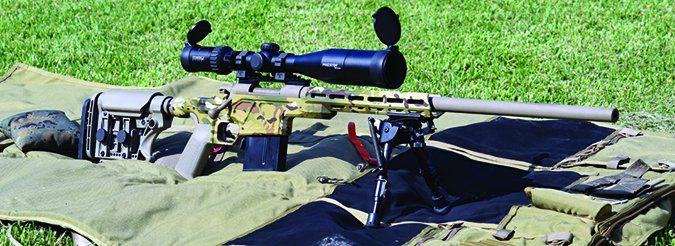
Legacy Sports of Reno, Nevada offers several different caliber barreled-actions by Howa that are ready for the stock of your choice. The Howa Chassis Rifle, or HCR for short, consisted of a Howa barreled action seated in a Sportrac Chassis from Accurate-Mag of Monroe, Connecticut. Available calibers for HCR include 243 Winchester and 308 Winchester, but our choice was a 24-inch-long barrel chambered for 6.5 Creedmoor, and it was as striking in appearance as any do-it-yourselfer could imagine. The one-piece aluminum chassis offered a multi-cam anodized finish and matching FDE Cerakote on the barreled action. This combination never failed to get a reaction at the public range.
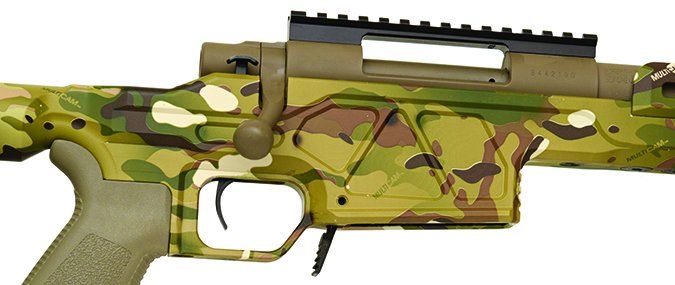
The chassis was extremely rigid, including the receiver, buttstock lead, and forend, which floated about 0.28 inches from the outer diameter of the No. 6-contour barrel. Bedding was accomplished by a V-block utilizing the original action screws plus a substantial recoil lug. The barrel measured about 0.82 inches in diameter at the muzzle, which was not threaded but did offer a recessed crown. The magazine well was integrated as well, offering a vertical paddle-release lever directly in front of the trigger guard. The vertical pistol grip was a plastic component typical to the AR-15/AR-10 platform and featured a beavertail extension across the web of the shooter’s hand. We liked the way the grip was smoothly integrated into the receiver. The bolt-lever handle was one-piece with the lever itself and slightly oversized. The trigger was black in color, and so was the two-position safety lever that rocked only about 0.25 inches rearward to its Safe position. The bolt-release lever was a small sheet-metal tab on the left side of the receiver. Our HCR did not ship with a scope mount, so we purchased a 20-MOA one-piece Picatinny rail from EGWguns.com for $70.
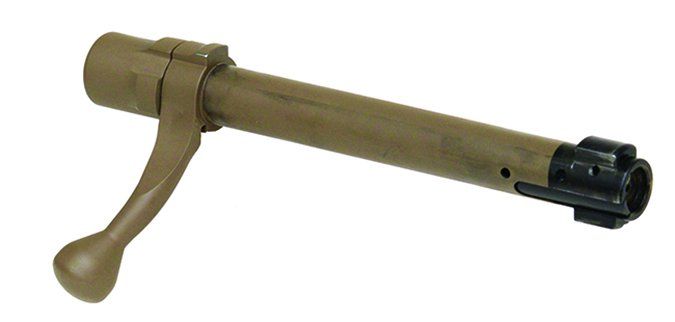
The supplied stock by LUTH-AR mounted on an AR-15/style tube that offered five positions altering length of pull. Loosening the locking wheel and extending the buttpad added an additional 1.1 inches. A second locking wheel allowed the operator to raise the comb about 0.8 inches. Adjustments remained true thanks in part to fine grooves on the mating surfaces, even when the locking wheels were not completely tight. The comb was comfortable to use, and there was a thumb-hook profile at the front face of the buttstock. The bottom ridge of the buttstock offered a Picatinny rail for attaching a monopod. Like the rest of the unit, the buttstock pad was constructed of glass-filled nylon but offered adjustability for height, as well as offset to the right or left. This was achieved by a series of horizontal channels, or a rack so to speak, through which the mounting screws could be secured. Whereas military and police often wear body armor that coincidentally absorbs recoil, we opted for the rubberized version of the buttpad from LUTH-AR aftermarket supply. This made quite a difference in shooter comfort.
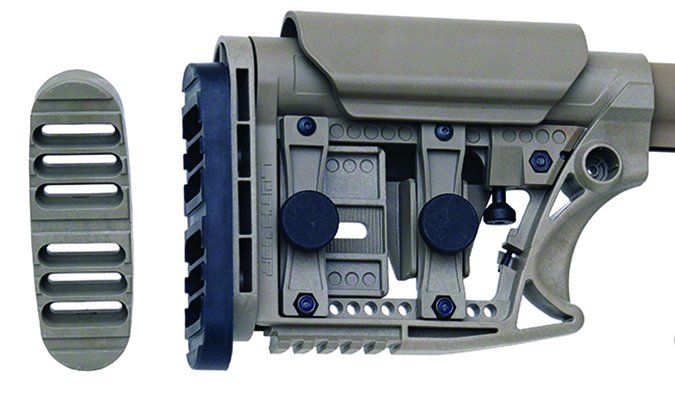
At the range, we found that the sub-3-pound trigger stroke began with a take-up that did not subtract from trigger-pull weight. In our view, it should not be considered a two-stage trigger. We also found that the magazine would not seat high enough to allow rounds to be extracted from the magazine by the oncoming bolt. Inserting the magazine with a good slap on the bottom cured the problem, but only for the first round. Whenever the magazine dropped away, we had to push upward on the base pad while working the bolt to get the rounds to feed. The problem persisted regardless of whether the 10-round magazine was full or held only the last round. We quickly ordered a second magazine directly from Accurate-Mag.com, ($66). The new magazine seemed to fit tighter, but the problem was not solved. We think changing the magazine catch would be the next step.
Even with the distraction of single-round shooting, we were able to land some tight groups. Final averages measured 0.8 inches, firing both Hornady’s 147-grain ELD Match and 143-grain Precision Hunter rounds. Most impressive of all was a 0.65-inch average for a five-shot group firing the Winchester 140-grain Match.
Our Team Said: Marred by a feeding problem, the HCR had an extremely solid feel mixed with a sense of simplicity. Its 10.25-pound base weight was evenly distributed, making it surprisingly portable. The LUTH buttstock offered adjustability that was quick and sure. We had expected the stock to feel cheap and plastic, but it proved to be neither, and, in our view, the synthetic construction helped absorb recoil. The rubber buttpad was certainly a plus as well. We were impressed with the strength of the chassis system and thought we had only scratched the surface of the HCR’s accuracy potential.
Ruger Hawkeye MkIV Varmint Target 17980 6.5 Creedmoor, $1139
GUN TESTS GRADE: B+
Maybe we should ding its grade further due to its rough bolt action, but in terms of accuracy, the Hawkeye deserved an A.

| ACTION TYPE | Bolt, 2 lugs |
| OVERALL LENGTH | 48 in. |
| BARREL | 28 in., 1:8 in. twist |
| OVERALL HEIGHT (w/o scope) | 5.75 in. |
| WEIGHT UNLOADED | 9.5 lbs. |
| WEIGHT LOADED (147-gr.) | 9.5 lbs. |
| SIGHT RADIUS | N/A |
| ACTION | Matte stainless steel; milled in scope base |
| MAGAZINE | 4-rd. internal box |
| STOCK | Black laminate 1-piece; rubber buttplate |
| STOCK LENGTH OF PULL | 13.5 in. |
| STOCK BEDDING | Direct to wood free float |
| TRIGGER PULL WEIGHT | 3 lbs. |
| SAFETY | 3-position lever |
| WARRANTY | None written |
| TELEPHONE | (336) 949-5200 |
| WEBSITE | Ruger.com |
| MADE IN | USA |
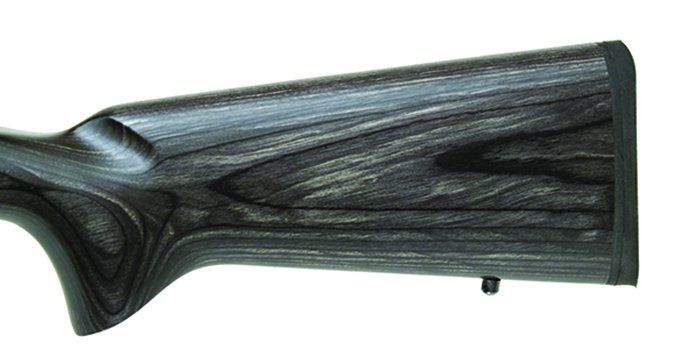
The first time we covered a Varmint Target rifle from Ruger was in the September 2008 issue of Gun Tests. It coincided with the introduction of a new cartridge, the 204 Ruger, and we had time to shoot it at prairie dogs in North Dakota. The subject of this evaluation features another newish round, the 6.5 Creedmoor, which has also been championed by Ruger, especially in the Ruger Precision Rifle. Nevertheless, our test rifle was a bit retro in comparison, utilizing a Mauser-type controlled feed action instead of Ruger’s new American action. Our Hawkeye Mark IV VT rifle was based on a heavy laminate stock and featured a 28-inch-long barrel, the longest barrel we’ve seen on a rifle in some time. Measuring 48 inches in overall length made finding a suitable carrying case a little bit of a challenge.
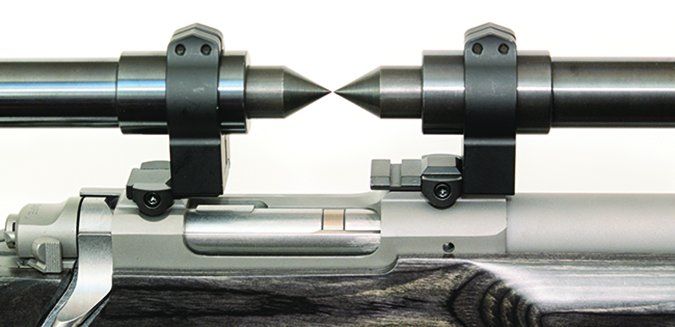
There was nothing trick about this rifle. It had a four-round internal magazine and hinged floorplate. The barrel was not threaded, but did offer a recessed crown. The stock was black laminate, not camouflaged. The action was listed as matte stainless, but some people think of it as Ruger gray. The action was topped with machined lugs to fit Ruger’s proprietary rings. It had a brief rubber buttpad and a three-position safety that allowed the chamber to be emptied by working the bolt while the trigger was disabled. One thing this rifle had that the 2008 model did not have was a trigger with little or no free take-up. The trigger traveled in a smooth arc, letting off at 3.0 pounds every time.
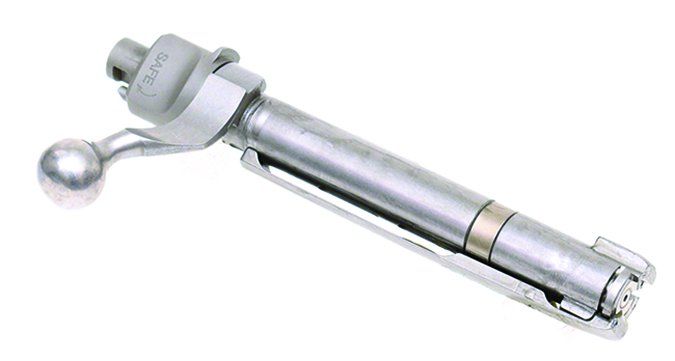
In mounting our Steiner scope, we decided to apply a Burris two-piece Ruger-to-Weaver Zee Ring Adapter (Brownells.com118-410-990WB, $33). Bear in mind there is nothing wrong with the proprietary rings and you can order the height and inner-diameter rings you want with the rifle. But we’ve had this base on our 2008 Ruger for about nine years and prefer the versatility it brings in terms of ring position and therefore eye relief. However, the first time you install the mount you have to be mindful of the mounting screws that lock in via a push-pull motion that can interfere with windage alignment. We used Brownells’ Sleeved alignment rods (080-918-000WB, $65) to make sure the rings were straight. At the range, we learned that the bolt action was rough, and rounds weren’t always eager to feed from the internal magazine. Removing the bolt for cleaning was also full of resistance. Oiling the bolt-release lever (found on the left side of the action) did help, but no amount of lubrication in lieu of break-in or hand fitting was going to improve the bolt action. We finally decided we didn’t want to be distracted by fighting with the bolt, so we top-loaded rounds for the remainder of our accuracy session. The big rifle, with its nice, wide flat forend, liked this routine. Once chambered, rounds were securely locked into place. The trigger was a pleasure to work, and we were rewarded with groups worthy of rifles costing three times as much. Measured center to center, our five-shot group average measured 0.7 inches with the Winchester 140-grain ammunition, but our best effort measured 0.55 inches across. Firing the 143-grain and 147-grain Hornady rounds, we landed 0.40-inch-wide groups, but the 147-grain ELD Match rounds also produced groups measuring just less than three-quarters of an inch. Groups fired with the 143-grain Precision Hunter rounds varied little from a measurement of 0.40 inches center to center.
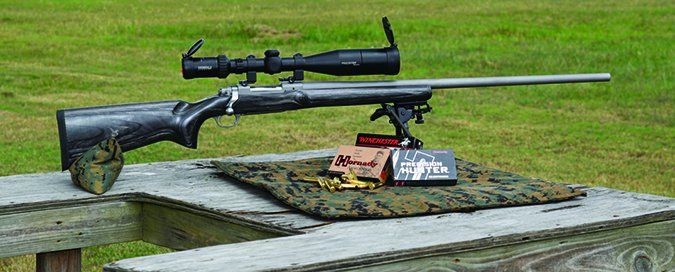
Our Team Said: We weren’t impressed with the Hawkeye’s sticky feeding or balky bolt release, so we limited our shooting to top-loading individual rounds. But we were impressed with this rifle’s accuracy. Once a round was loaded, the lockup was solid, and the trigger was remarkably consistent. This is not a tactical or a patrol rifle. But for shooting from a bench on the open range or at a match, this gun is a flat-out bargain.
Written and photographed by Roger Eckstine, using evaluations from Gun Tests team testers.



